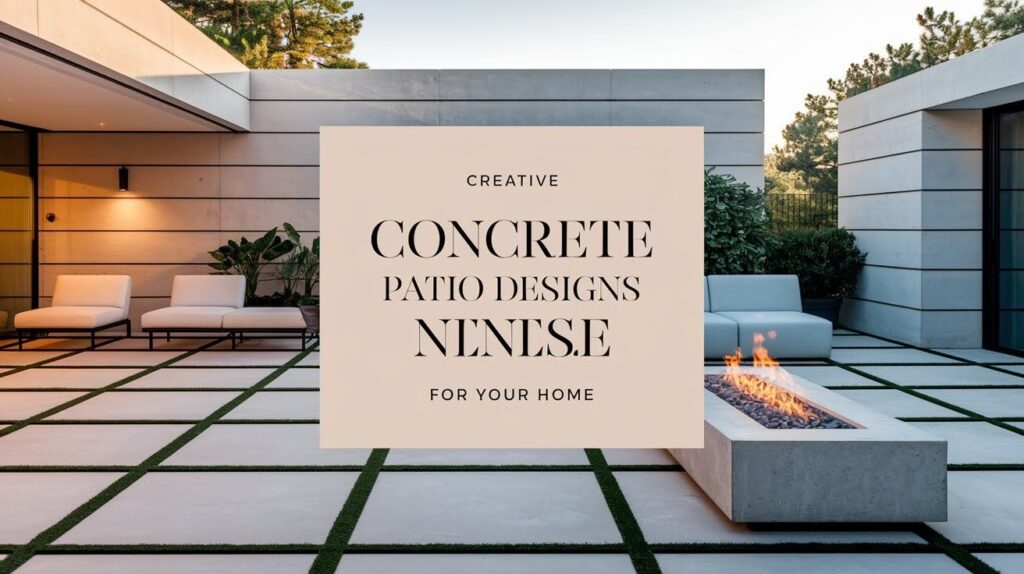Concrete patios have become a cornerstone of modern outdoor living, offering unmatched versatility and long-lasting durability that homeowners can rely on for decades. What was once considered a basic, utilitarian material has undergone a remarkable transformation.
Today’s concrete has moved far beyond simple gray slabs to become a canvas for sophisticated outdoor design statements that rival any traditional paving material.
This evolution reflects a growing understanding of how functional spaces can simultaneously serve as beautiful focal points. Modern concrete techniques allow homeowners to create patios that seamlessly blend practical benefits with visual appeal.
From stamped patterns that mimic natural stone to colored finishes that complement architectural styles, creative concrete applications prove that durability and beauty aren’t mutually exclusive concepts in contemporary patio design.
Why Choose Concrete for Your Patio?
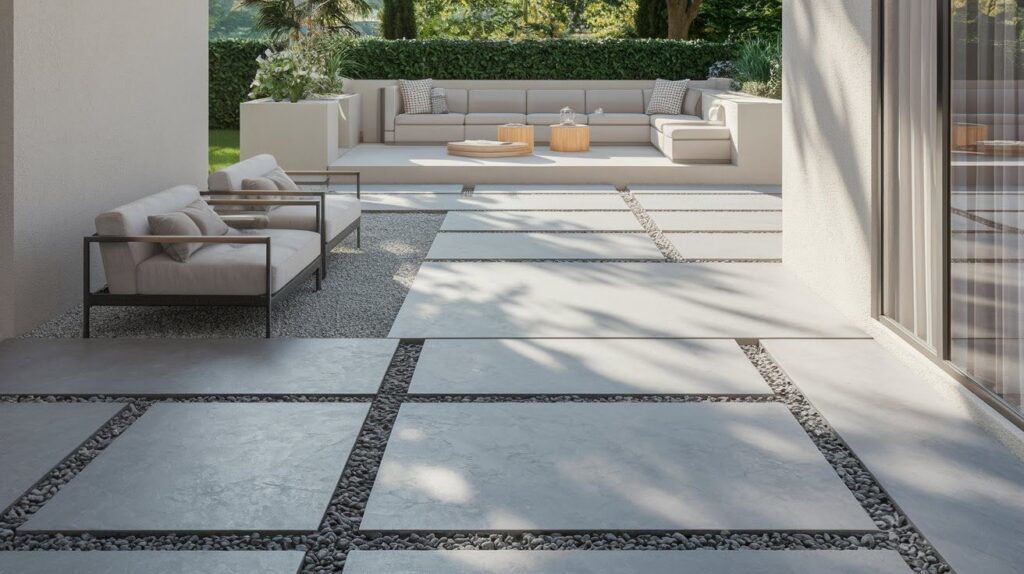
When planning your outdoor space, concrete emerges as a smart choice that delivers on multiple fronts. Here’s what makes it such an appealing option for homeowners:
Built to Last- Concrete patios handle whatever life throws at them. From scorching summer heat to freezing winter temperatures, heavy furniture, and constant foot traffic, this material stands strong year after year. You won’t find yourself replacing or repairing sections every few seasons.
Endless Design Possibilities- Today’s concrete isn’t limited to one look. Advanced techniques allow it to replicate the appearance of natural stone, brick, or even wood planking. Alternatively, you can opt for bold colors, intricate patterns, or smooth contemporary finishes that make a statement all their own.
Smart Investment- You get the visual impact of premium materials without the hefty price tag. Concrete delivers that high-end appearance while keeping your budget reasonable, making it possible to create impressive outdoor spaces without overspending.
Minimal Upkeep Required- Once properly sealed and finished, concrete patios need little ongoing attention. Regular cleaning and occasional resealing keep them looking fresh for years, freeing up your time for actually enjoying your outdoor space.
15 Creative Concrete Patio Designs for Your Home
1. Stamped Concrete That Mimics Natural Stone
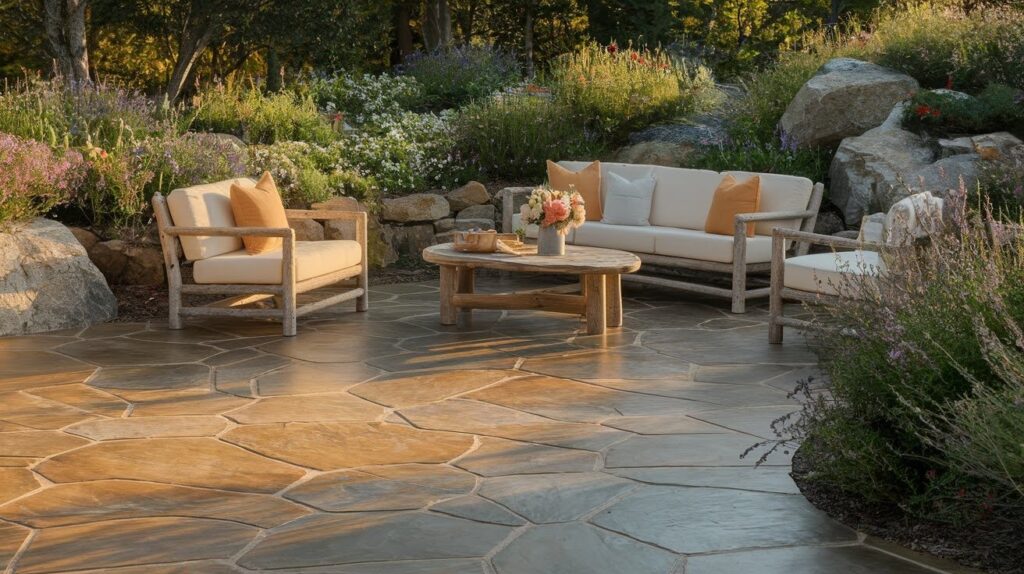
Transform your patio with stamped concrete that captures the beauty of slate, flagstone, or brick without the cost.
This technique works beautifully with rustic, traditional, or farmhouse home styles, creating an authentic look that complements natural surroundings while providing the durability concrete is known for.
Professional installers can match specific stone patterns you admire, ensuring your patio coordinates perfectly with existing hardscaping elements.
2. Wood-Look Stamped Concrete
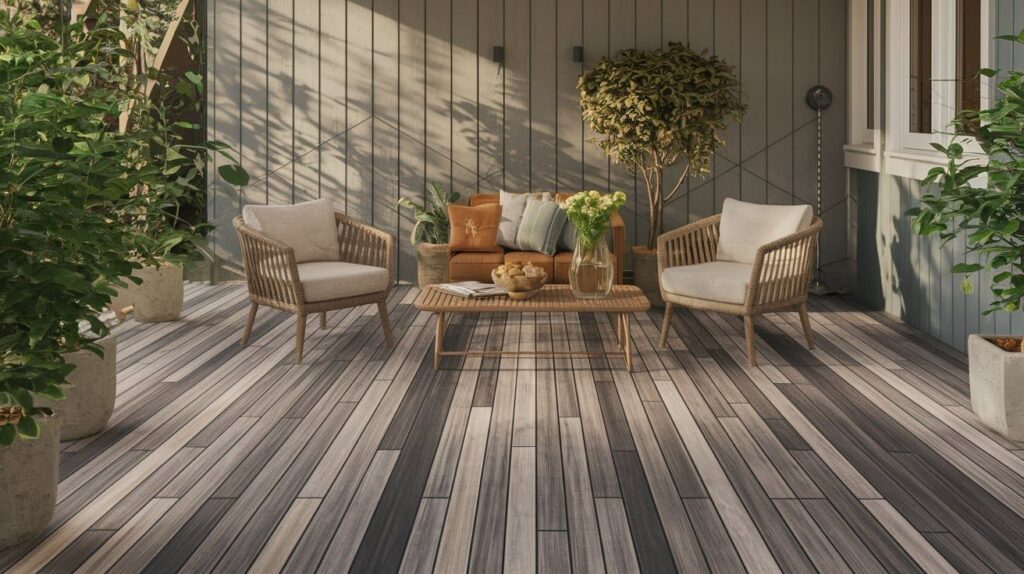
Enjoy the warm appeal of wood decking without worrying about splinters, rot, or constant staining. You can choose from various shades, from weathered reclaimed barnwood tones to soft driftwood grays, giving you the cozy feel of timber with concrete’s practical benefits.
This option works particularly well in areas where real wood would be impractical due to moisture or heavy use.
3. Checkerboard Concrete With Grass or Turf
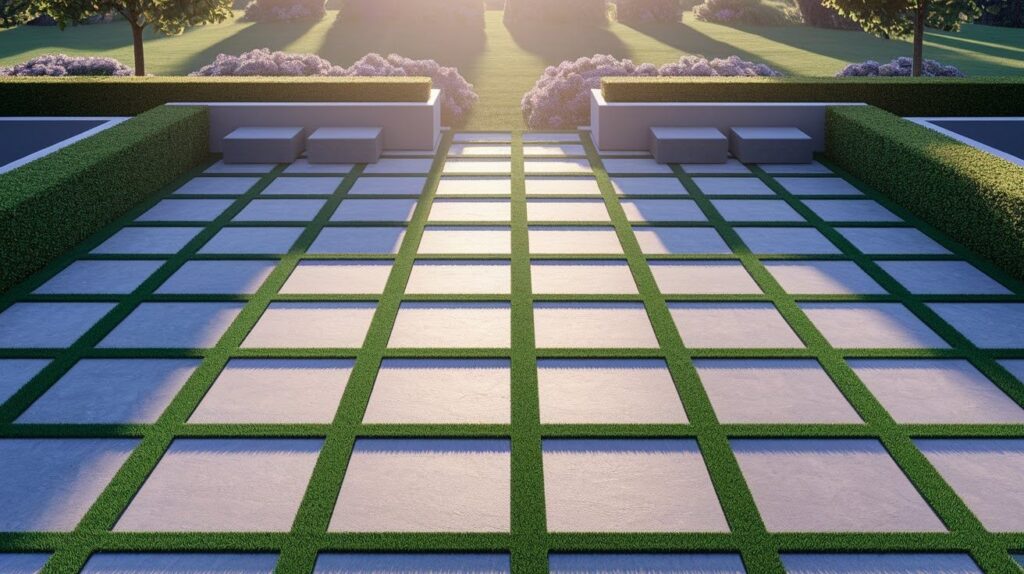
Create visual interest by alternating concrete squares with patches of green grass or artificial turf. This bold design adds drama through the contrast between gray concrete and vibrant green, while artificial grass keeps maintenance to a minimum.
This design approach also helps reduce the overall amount of concrete needed, making it an economical choice for larger patio areas.
4. Seamless Concrete Slabs for a Minimalist Look
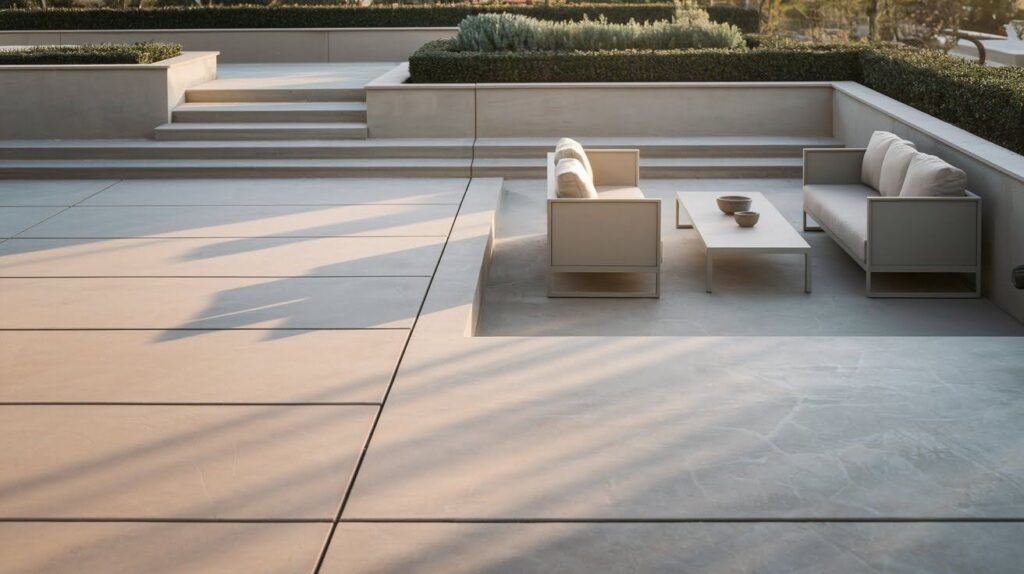
For modern and contemporary homes, large seamless concrete slabs offer clean lines and sophisticated simplicity.
This approach focuses on smooth surfaces and geometric precision, creating a calm, uncluttered outdoor space that feels both spacious and refined.
This style pairs beautifully with minimalist outdoor furniture and architectural landscaping featuring clean-lined planters and geometric plant arrangements.
5. Concrete Slabs with Groundcover Insets
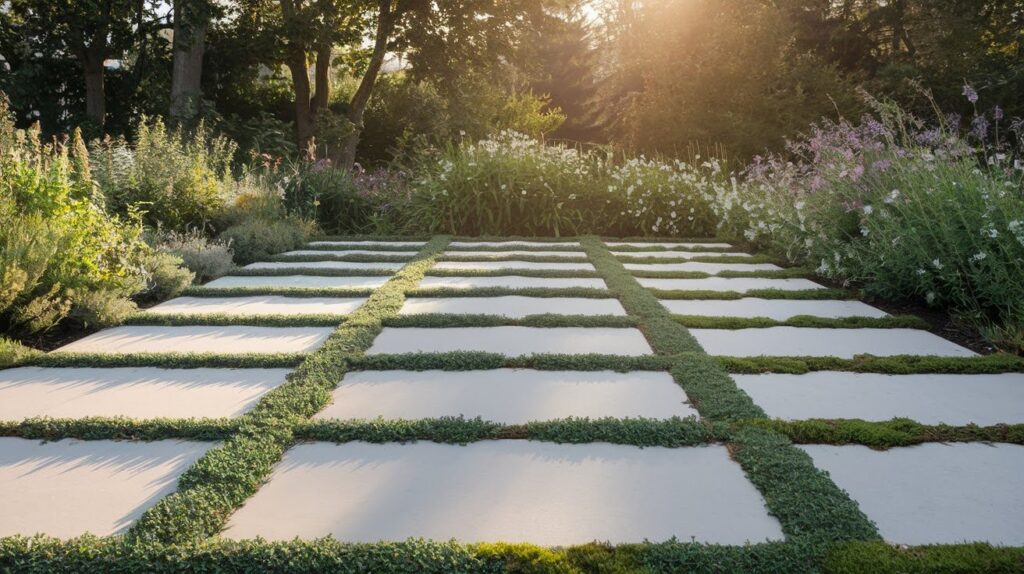
Soften the hard edges of concrete by incorporating living groundcover like creeping thyme or moss between slabs. These plants add natural texture, color, and pleasant fragrance while creating a more organic feel that connects your patio to the surrounding landscape.
Regular foot traffic actually helps many groundcover plants spread and thicken, creating a more lush appearance over time.
6. Spray Texture or Knockdown Finish
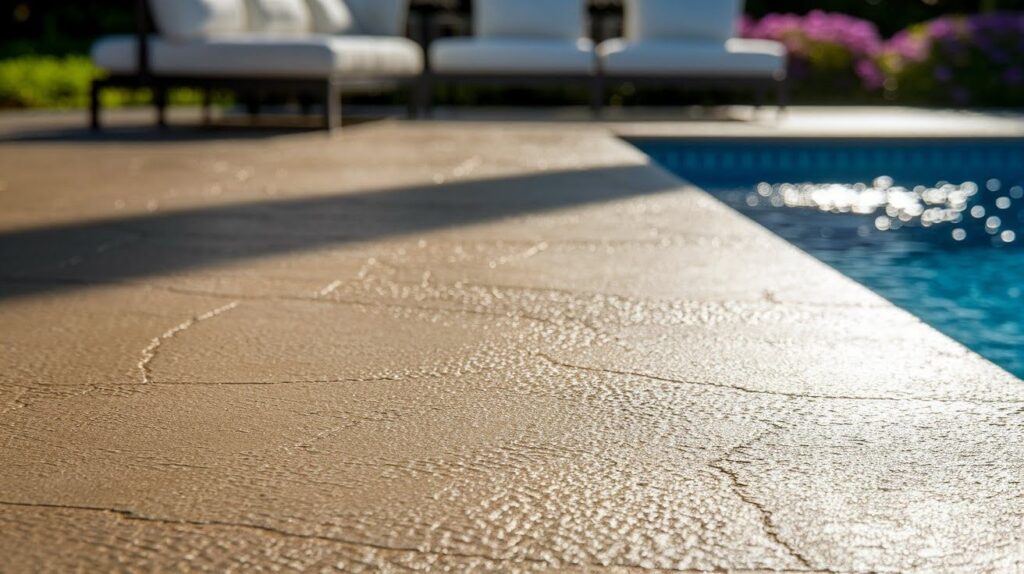
This textured surface feels comfortable underfoot while providing excellent slip resistance. The technique works particularly well around pools or in high-traffic areas where safety and comfort are priorities, creating a surface that’s both functional and visually appealing.
You can customize the texture level from subtle to pronounced, depending on your aesthetic preferences and functional needs.
7. Painted or Stenciled Concrete

Personalize a basic concrete slab with painted patterns, mandalas, or custom borders. This budget-friendly approach allows you to add personality and style to existing concrete, making it possible to completely change the look of your patio without major reconstruction.
Specialty concrete paints are designed to withstand outdoor conditions, though periodic touch-ups may be needed to keep colors vibrant.
8. Exposed Aggregate Finish
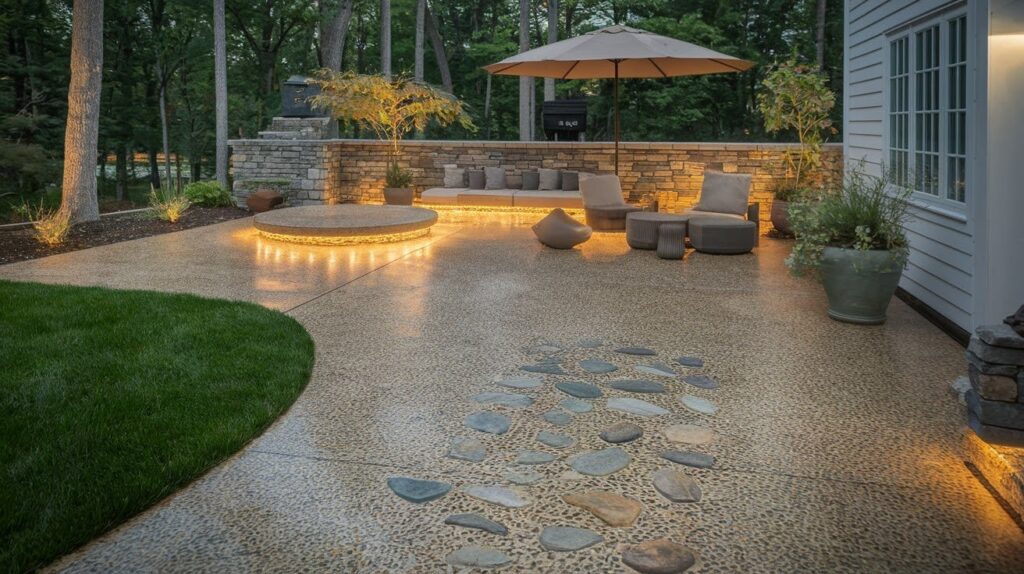
This technique reveals decorative stones and pebbles within the concrete, creating a naturally textured surface that’s both beautiful and slip-resistant.
The varied colors and shapes of the aggregate add visual depth while providing excellent traction for walkways and patio areas. The finish becomes more beautiful with age as weather naturally cleans and polishes the exposed stones.
9. Charcoal Gray and Bold Accent Colors
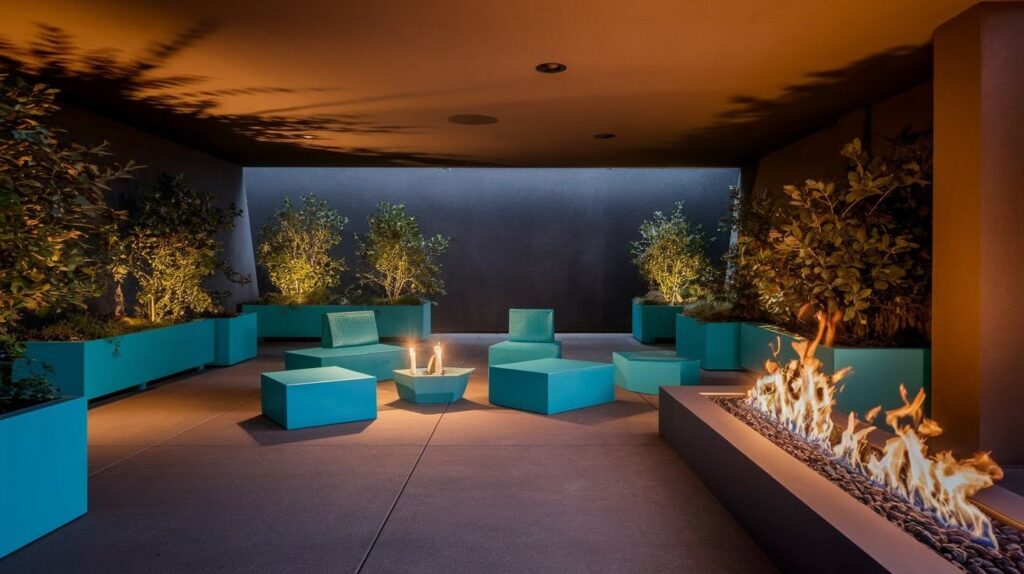
Make a statement with dramatic charcoal gray concrete paired with bright accent colors. This modern approach creates striking contrast and works beautifully with contemporary outdoor furniture and fire features, giving your space a sophisticated, gallery-like quality.
Strategic use of accent colors through borders, inlays, or geometric shapes can tie the patio design to your home’s exterior color scheme.
10. Large Format Concrete Tiles

Oversized square or rectangular concrete pads create a modular look that feels both structured and flexible.
Combine these large tiles with gravel or decorative stone between joints for a contemporary design that allows for easy future modifications.
This design works particularly well for DIY enthusiasts, as smaller sections are more manageable to pour and finish than one large continuous slab.
11. Trimmed With Brick or Stone Borders
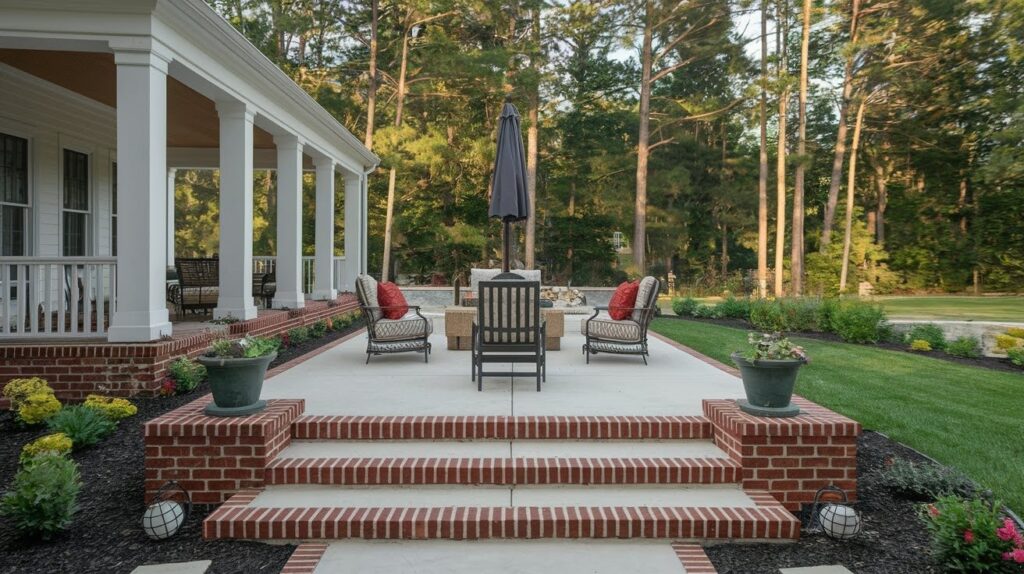
Add visual interest by framing your concrete patio with brick or natural stone borders. This combination approach brings traditional warmth to practical concrete, creating defined edges that feel both classic and purposeful.
Border materials can also serve practical purposes, such as creating level transitions or providing drainage channels around the patio perimeter.
12. Integrated Concrete Features
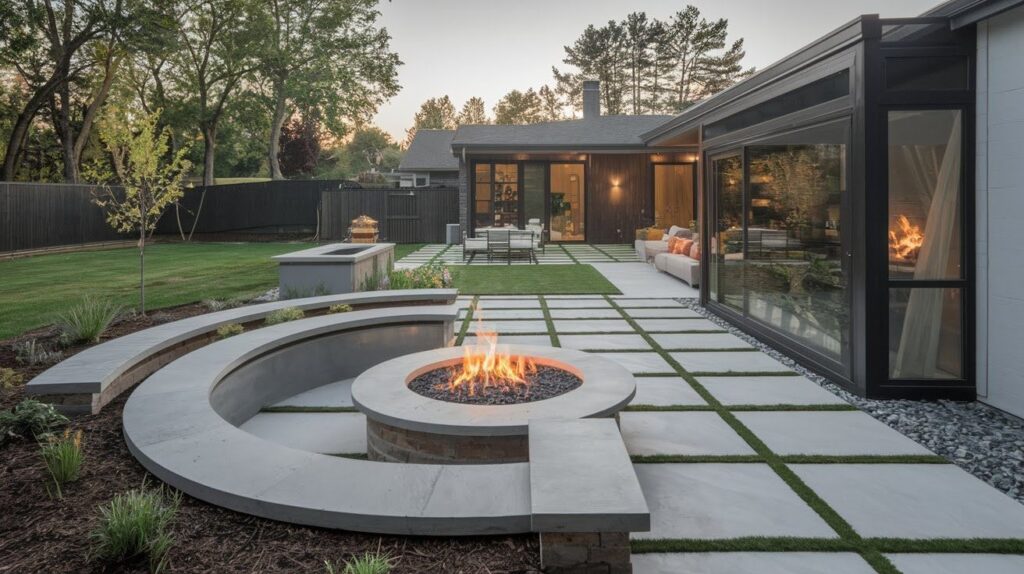
Design your patio with built-in elements like fire pits, benches, or planters poured as part of the original installation. This approach creates a cohesive look while saving on materials and ensuring that all elements work together seamlessly.
The integrated approach also maximizes space efficiency, as built-in seating and features take up less room than standalone furniture pieces.
13. Stained Concrete in Earthy or Custom Hues
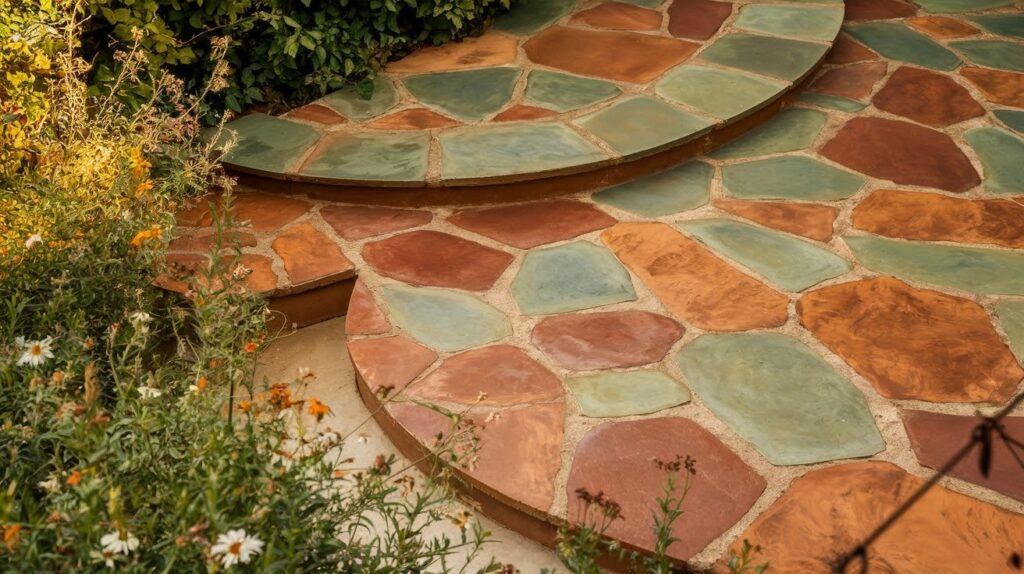
Move beyond gray with acid stains that create rich, warm tones like terracotta, chestnut, or sage green. You can layer multiple colors for depth and complexity, turning your patio into a work of art that complements your home’s color scheme.
The staining process often creates natural variations and mottling that add character and prevent the surface from looking flat or artificial.
14. Geometric or Compass-Inspired Stamping

Stand out with bold, unique patterns that turn your patio into a focal point. These designs work especially well on larger patios or entertaining areas where the pattern has room to make a full visual impact.
The raised and recessed areas of stamped patterns create subtle shadows that change throughout the day, adding dynamic visual interest to your outdoor space.
15. Curved or Freeform Patio Shapes
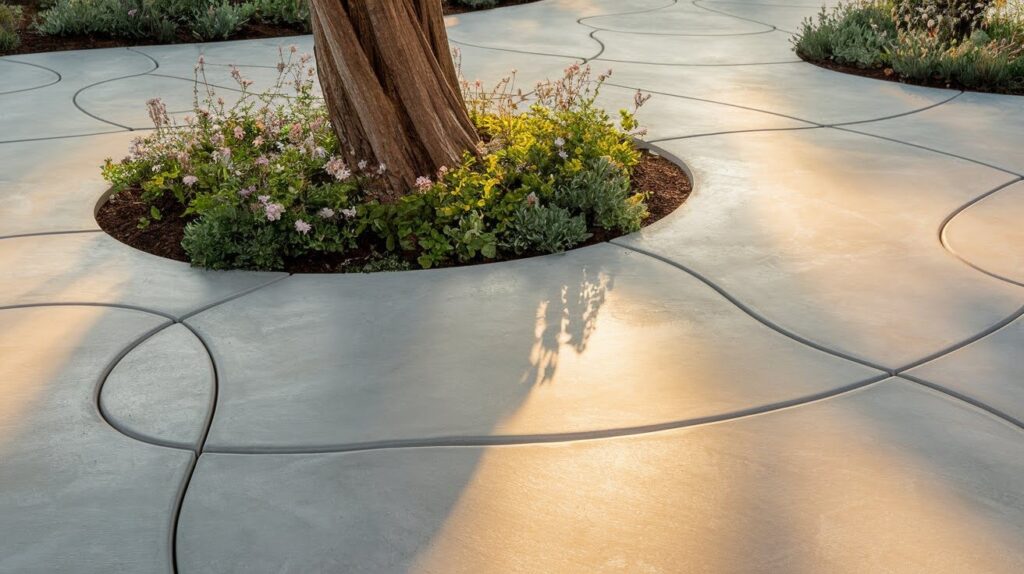
Break away from standard rectangular layouts with flowing, organic shapes that follow your landscape’s natural contours. Curved patios create better traffic flow and can make your outdoor space feel more integrated with gardens and existing features.
Curved forms also allow you to work around existing trees, slopes, or other landscape features rather than having to remove or drastically modify them.
Conclusion
These 15 designs demonstrate that concrete has evolved far beyond its utilitarian roots to become a truly versatile design material. Today’s concrete options rival natural stone, wood, and other premium materials in both beauty and functionality, proving that practical choices don’t require sacrificing style.
Rather than viewing concrete as merely a budget alternative, consider it a design-forward solution that offers creative possibilities limited only by your imagination.
From intricate stamped patterns to bold color combinations, concrete provides the foundation for outdoor spaces that reflect your personal style while standing the test of time.
Ready to transform your patio? Start by consulting with experienced contractors for complex installations, or begin with simple painted designs to test your creative vision before committing to larger projects.
Frequently Asked Questions (FAQs)
How long does a concrete patio typically last?
A well-installed concrete patio can last 25-30 years or more with proper care and maintenance. Regular sealing every 2-3 years helps protect against weather damage and extends the surface life significantly.
Can I add decorative finishes to existing plain concrete?
Yes, many decorative options like staining, painting, or applying overlays can transform existing concrete surfaces. These treatments work best on concrete that’s in good structural condition without major cracks or damage.
What’s the best time of year to install a concrete patio?
Spring through early fall offers ideal conditions, with temperatures between 50-85°F and low humidity. Avoid installation during freezing weather or extremely hot summer days when concrete can cure too quickly.
How much does decorative concrete cost compared to regular concrete?
Decorative concrete typically costs 2-4 times more than plain concrete, ranging from $8-15 per square foot installed. However, this still remains less expensive than natural stone or high-end pavers while offering similar visual appeal.
Do I need special maintenance for stamped or textured concrete?
Textured surfaces require gentle cleaning with soft brushes to avoid damaging patterns, plus regular sealing to maintain color and protection. Avoid harsh chemicals or pressure washing that could erode surface details over time.

